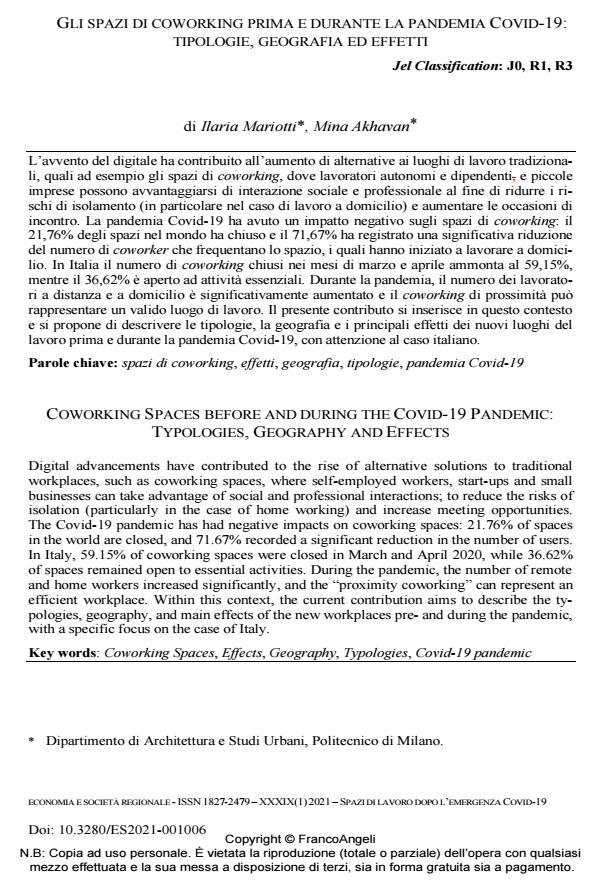Gli spazi di coworking prima e durante la pandemia covid-19: tipologie, geografia ed effetti
Titolo Rivista ECONOMIA E SOCIETÀ REGIONALE
Autori/Curatori Ilaria Mariotti, Mina Akhavan
Anno di pubblicazione 2021 Fascicolo 2021/1
Lingua Italiano Numero pagine 19 P. 66-84 Dimensione file 362 KB
DOI 10.3280/ES2021-001006
Il DOI è il codice a barre della proprietà intellettuale: per saperne di più
clicca qui
Qui sotto puoi vedere in anteprima la prima pagina di questo articolo.
Se questo articolo ti interessa, lo puoi acquistare (e scaricare in formato pdf) seguendo le facili indicazioni per acquistare il download credit. Acquista Download Credits per scaricare questo Articolo in formato PDF

FrancoAngeli è membro della Publishers International Linking Association, Inc (PILA)associazione indipendente e non profit per facilitare (attraverso i servizi tecnologici implementati da CrossRef.org) l’accesso degli studiosi ai contenuti digitali nelle pubblicazioni professionali e scientifiche
L’avvento del digitale ha contribuito all’aumento di alternative ai luoghi di lavoro tradizionali, quali ad esempio gli spazi di coworking, dove lavoratori autonomi e dipendenti, e piccole im-prese possono avvantaggiarsi di interazione sociale e professionale al fine di ridurre i rischi di isolamento (in particolare nel caso di lavoro a domicilio) e aumentare le occasioni di incontro. La pandemia Covid-19 ha avuto un impatto negativo sugli spazi di coworking: il 21,76% de-gli spazi nel mondo ha chiuso e il 71,67% ha registrato una significativa riduzione del numero di coworker che frequentano lo spazio, i quali hanno iniziato a lavorare a domicilio. In Italia il numero di coworking chiusi nei mesi di marzo e aprile ammonta al 59,15%, mentre il 36,62% è aperto ad attività essenziali. Durante la pandemia, il numero dei lavoratori a distanza e a do-micilio è significativamente aumentato e il coworking di prossimità può rappresentare un vali-do luogo di lavoro. Il presente contributo si inserisce in questo contesto e si propone di de-scrivere le tipologie, la geografia e i principali effetti dei nuovi luoghi del lavoro prima e du-rante la pandemia Covid-19, con attenzione al caso italiano.
Parole chiave:Spazi di coworking, effetti, geografia, tipologie, pandemia Covid-19
Jel codes:J0, R1, R3
- European Narratives on Remote Working and Coworking During the COVID-19 Pandemic Aleid Elizabeth Brouwer, Ilaria Mariotti, pp.9 (ISBN:978-3-031-26017-9)
- Handbook of Labor, Human Resources and Population Economics Ilaria Mariotti, Mina Di Marino, Mina Akhavan, Ignasi Capdevila, pp.1 (ISBN:978-3-319-57365-6)
Ilaria Mariotti, Mina Akhavan, Gli spazi di coworking prima e durante la pandemia covid-19: tipologie, geografia ed effetti in "ECONOMIA E SOCIETÀ REGIONALE " 1/2021, pp 66-84, DOI: 10.3280/ES2021-001006